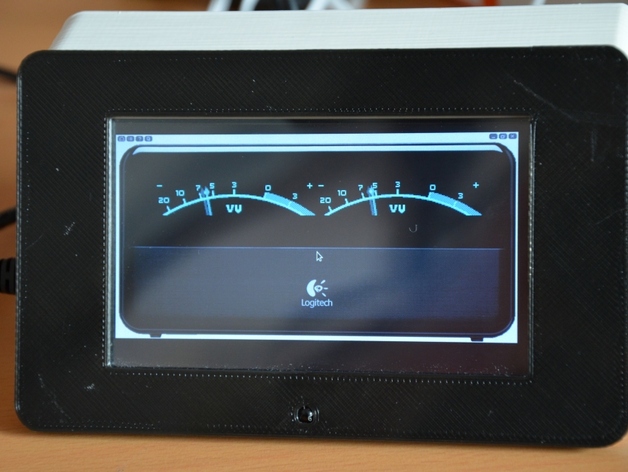
RaspberryPi Squeezebox
thingiverse
Here is my design of an enclosure for a squeezebox based on a Raspberry Pi2, Hifiberry DAC+, and Watterott 5" HDMI Touchscreen-Display. Watch the video at https://www.youtube.com/watch?v=tN6ngN8lytw Instructions: Part P03_Case should be printed with support but without closing USB and Network breakout holes with pillars (in Slic3r). Enable "Don't support bridges" for this. Check out the pictures and the FreeCAD file to see how it's assembled, as they're self-explanatory. You need these materials: - Raspberry Pi2 (Raspberry Pi B+ also works) - 5"-Touchscreen Display http://www.watterott.com/de/5-800x480-HDMI-Display-mit-resistivem-Touchscreen - Hifiberry DAC+, Version A RCA http://www.watterott.com/de/HiFiBerry-BPlus-DAC-RCA-version or https://www.hifiberry.com/product/hifiberry-dacplus-rca-version/ - IR receiver, 38 kHz, 950 nm, Vishay TSOP4838 e.g. http://www.conrad.de/ce/de/product/171115/IR-Empfaenger-Sonderform-axial-bedrahtet-38-kHz-950-nm-Vishay-TSOP4838 - Micro USB plug Type B, 2 pieces - USB-A plug, 90° angle, 1 piece - HDMI plug, version 1.3, 2 pieces - M3x10 bolts, 4 pieces - Cynch panel jacks, 2 pieces - Socket for hollow mounting of the power supply (1) and some self-tapping screws. Assemble your own USB and HDMI cables since commercial options won't fit in the case. I built both from single wires. Raspberry Pi HDMI output is connected to the watterott output adapter's HDMI-in. Raspberry Pi USB goes to Watterott Display Adapter data-In. Rewire hifiberry soldered cych plug connections for signals of each Hifi-output at rear panel, then remove cych plug connectors since they are too big to fit in case. IR reciever fits in the center hole at front panel and is connected to +3.3V GND and GPIO14 with individual wires. Build a cable from micro USB-plug and attach it to power jack at rear panel. Software: Use Raspberry Pi Raspbian OS 3.18 as instructed on the official Raspberry website, Install hifiberry driver in hifiberry forum, install watterott firmware for adapter in adapter repository at github. See the instructions in configuration files (github). Adjust the config.txt to set required settings of your Watterott display. Get and copy softsqueeze Windows version, what you need is SoftSqueeze.jar at sourceforge site from folder downloaded at home directory of pi. Install it with LXDE session on pi then reboot and it will come up without desktop but running with Ssoftsqueeze. For infrared remote install LIRC on your raspberryPi. You can also see how to get more details on setup with hardware.conf. You should change the following file for using remote IR at raspberry (hardware.confg /lirc/risc.conf). Set dtv_overlay to "lirc-rpi,gpio_in_pin=14".
With this file you will be able to print RaspberryPi Squeezebox with your 3D printer. Click on the button and save the file on your computer to work, edit or customize your design. You can also find more 3D designs for printers on RaspberryPi Squeezebox.
